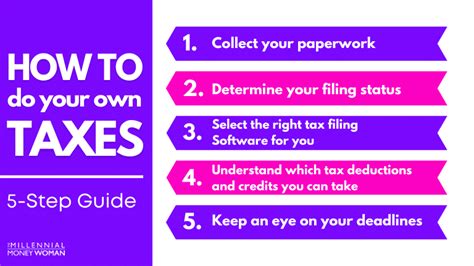How To Do Your Taxes: A Step-by-Step Guide
Doing your taxes can feel daunting, but with a structured approach and the right resources, it becomes manageable. This guide breaks down the process into simple steps, helping you navigate tax season with confidence.
Step 1: Gather Your Documents
Before you even think about filling out forms, gather all necessary documents. This is the most crucial first step, and neglecting it can lead to delays and errors. Make sure you have:
- W-2 Forms: These show your wages and the taxes withheld from your employer.
- 1099 Forms: If you're a freelancer or have other income sources (like interest or dividends), you'll receive 1099 forms detailing these earnings.
- Receipts for Deductions: Keep records of charitable donations, medical expenses, business expenses (if self-employed), and other deductible items. Organize these meticulously! This will save you significant time and frustration later.
- Social Security Number (SSN): You'll need this for yourself and any dependents you're claiming.
- Prior Year's Tax Return: Comparing this year's return to last year's can help identify potential changes and discrepancies.
Step 2: Choose Your Filing Method
There are several ways to file your taxes:
- Online Tax Software: Programs like TurboTax, H&R Block, and TaxAct guide you through the process step-by-step and perform calculations automatically. They're generally user-friendly and offer various support options.
- Tax Professionals: CPAs and enrolled agents can handle your taxes for you, especially beneficial if your tax situation is complex.
- Manually Filing a Paper Return: This is the least efficient method but still an option. You'll need to download the appropriate forms from the IRS website and complete them by hand.
Step 3: Determine Your Filing Status
Your filing status significantly impacts your tax liability. Common statuses include:
- Single: You're unmarried and don't qualify for any other status.
- Married Filing Jointly: You're married and file a single return with your spouse.
- Married Filing Separately: You're married but file separate returns.
- Head of Household: You're unmarried and support a qualifying person.
- Qualifying Widow(er) with Dependent Child: This applies for two years after the death of a spouse.
Step 4: Claim Your Deductions and Credits
This is where you can potentially lower your tax bill. Familiarize yourself with common deductions and credits:
- Standard Deduction: A set amount you can deduct regardless of itemized deductions.
- Itemized Deductions: Deductions for specific expenses like medical expenses, charitable contributions, and mortgage interest (if applicable). You can only take either the standard deduction or itemized deductions, whichever results in a lower tax liability.
- Tax Credits: Directly reduce your tax owed. Examples include the Earned Income Tax Credit (EITC) and Child Tax Credit.
Step 5: File Your Return
Once you've completed your tax form(s), review everything carefully for accuracy. Double-check your calculations and ensure all information is correct before submitting. If filing online, follow the software's instructions. If filing manually, mail your return to the appropriate IRS address.
Step 6: Understand Your Tax Liability
After filing, you'll receive a notice confirming your tax return was received. If you owe taxes, make sure to pay on time to avoid penalties. If you're due a refund, it will be issued according to the IRS processing times.
Key Considerations:
- Deadlines: Be aware of the annual tax filing deadline to avoid penalties.
- State Taxes: Don't forget to file state taxes if required in your state.
- IRS Resources: The IRS website offers a wealth of information, forms, and publications.
Doing your taxes doesn't have to be stressful. By following these steps and utilizing the available resources, you can navigate the process efficiently and accurately. Remember, accuracy is paramount – take your time and don't hesitate to seek professional assistance if needed.
